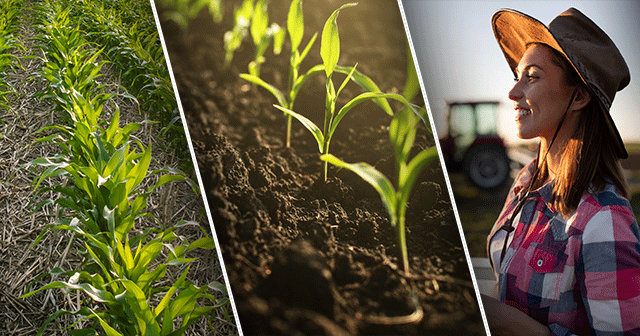The pinnacle report on the state of U.S. agriculture and ranching was released in February. Collected once every five years by the United States Department of Agriculture (USDA) National Agricultural Statistics Service, the 2022 Census of Agriculture is a 757- page document spanning more than 6 million data points on land use and ownership, operator characteristics, production practices, income, and expenditures. The data also serves as a bellwether for the state of sustainability in agriculture.
Here are my three key takeaways from the census.
1. Change is coming, but slower than we need
Compared to the 2017 census, no-till practices and cover crops were up but not at the rate needed to keep pace with climate change. Thirty-eight percent of farms reported using no-till practices in 2022, which is 1.1% more than five years ago. Cover crop acres increased to 18 million total acres, a 17% increase, but when compared to total farmland, this represents only 6% of 300 million acres.
As Emma Fuller at Fractal Agriculture pointed out, “at the current rate, it’d take us 90 years to achieve cover crop adoption on 50% of corn and soy acres in the U.S.” That is 84 years past the desired 2030 goal.
An increasing emphasis is being placed on technical assistance around sustainable practice adoption—investing not just in hitting numbers but doing it right.
Through a USDA grant incentivizing cover crop use, Farmers For Soil Health has a goal of doubling the number of corn and soybean acres using cover crops to 30 million acres by 2030. The group, which includes DTN as a technology partner, estimates that the goal is achievable if cover-crop acres increased by 1.7 million acres annually. The recent census shows annual cover crop usage slightly more than 600,000 acres since 2017.
This does not have to be indicative of the next five years. Several companies in the ag tech and sustainability arena have made strides to automate enrollment for different Natural Resources Conversation Service benefits. (Historically, this process has proven complex to access funds through the Environmental Quality Incentives Program and other incentive programs.)
An increasing emphasis is being placed on technical assistance around sustainable practice adoption – investing not just in hitting numbers but doing it right. With easier program enrollment, greater transparency in benefits, additional financing options and better yield outcomes and profitability, the path to 30 million acres begins to look achievable.
2. Sustainability Extends Beyond the Soil
We are seeing many sustainability conversations for agriculture centered around the carbon intensity of crops and the heightened demand for corn and soybean for renewable fuels.
The 45Z Clean Fuel Credit, which takes effect in 2025, incentivizes biofuel and ethanol producers to increase production of renewable fuels using low carbon-intensive grains. I believe one positive side-effect of the tracking and reporting necessary for 45Z and other biofuel incentive programs is that the 2027 USDA Ag Census will have richer and validated sustainability data.
One of the positive side-effects of the tracking and reporting for biofuel incentive programs is richer and validated sustainability data.
But the 2022 census shows another side of sustainability: the use of renewable fuels on farms and ranches. Renewable energy options can help farmers increase energy independence, reduce operational costs, and offset energy.
A total of 153,101 farms and ranches are using renewable energy producing systems, a 15% increase from 2017. They reported using a diversity of renewable sources—from biomass and biogas to hydroelectric energy, hydrogen, geothermal and wind—but the majority, 76%, reported using solar panels.
3. We need to entice the younger generation back to the farm
The average age of the American farmer rose to 58.1 years old in 2022, up 0.6 years from 2017. Nine percent of farmers counted were “Young Producers,” defined as 34 years of age or younger. When you overlay this data point with the fact that the U.S. lost nearly 142,000 farms during that same time it magnifies the need to entice the younger generation to become farmers and ranchers.
Agriculture Secretary Tom Vilsack addressed this concern in his response to the 2022 Ag Census results. “We continue to see the aging nature of our farming community,” Vilsack noted. “We recognize the importance of making the case to bright young people about the career opportunities and the changes that you have to make a fundamental difference in agriculture and food.”
The concern for sustainability will be an impetus for younger people to become farmers.
I believe the concern for sustainability will be an impetus for younger people to become farmers. Climate change is a top priority for Generation Z, according to a recent McKinsey report. And they, along with millennials, are the most interested in sustainable food options (and perhaps the most likely to pay for low-carbon products).
The younger generations are often more willing to embrace new technology and challenge the “status quo” to spur innovation in both agricultural practices and sustainability. One farmer, who by census definition is a young farmer, told me he believed that “sustainability is what will bring the detached generation back to the farm.”
If his prediction holds true, and I hope it does, then we should see promising data in the 2027 census that points to a more sustainable agriculture industry.
Find out more about how DTN supports confident decisions for sustainable agriculture by visiting EcoField data.
About the author:
Jess Bollinger is Head of Sustainability, Agriculture & Energy for DTN. She has more than a decade of experience in the fields of sustainability, public policy, and global programs, including facilitating global partnerships for UNICEF USA. She has presented at multiple sustainability events including The Sustainability Consortium and GSMA Mobile 360.











